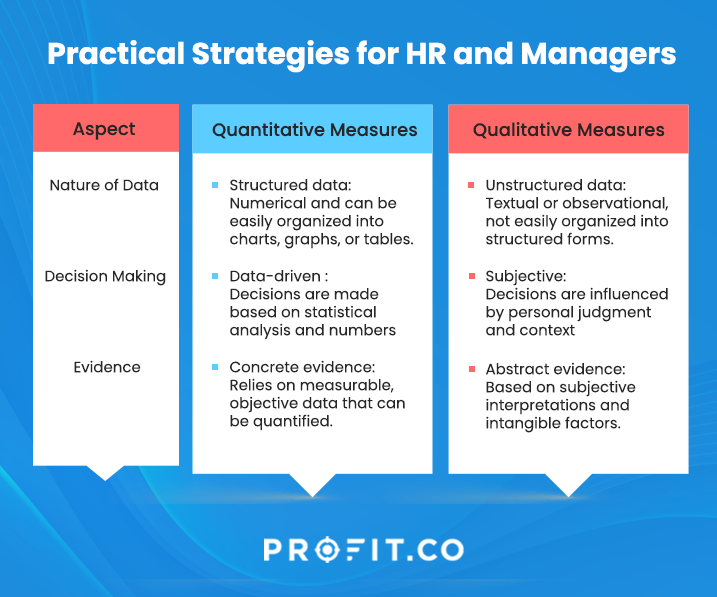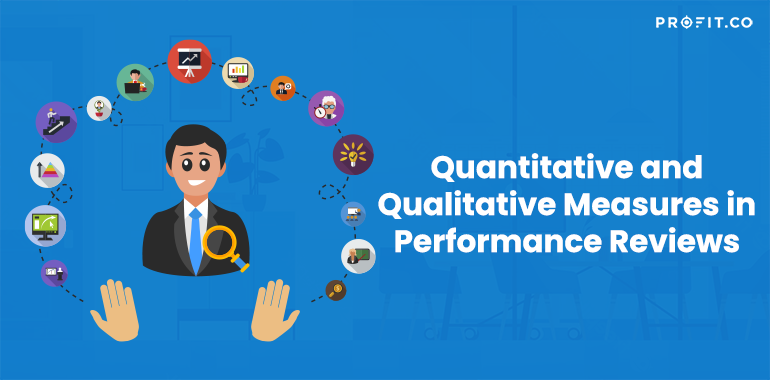Why Numbers Matter?
Numbers are your friends in performance reviews. They provide concrete evidence of achievements, like hitting sales targets, exceeding quotas, or streamlining processes that saved the company time and money. These metrics are objective, easy to track, and depict how someone performs in their role. But here’s the catch: numbers only tell part of the story. Let’s say you have a superstar salesperson who consistently crushes their quota. Fantastic! But what about their teamwork skills? Are they supportive colleagues who help others succeed? Numbers won’t tell you that.Qualitative measures exploring the “why” behind the “what.”
- Problem-solving skills: Did they take the initiative to tackle a complex issue and find a creative solution?
- Communication: Are they clear, concise, and able to effectively convey ideas to colleagues and clients?
- Leadership: Do they inspire and motivate others? Do they foster a positive team environment?
- Adaptability: Can they roll with the punches and adjust to changing priorities?
- Customer service: Do they go the extra mile to ensure customer satisfaction?
Numbers are great, but stories stick
Don’t just say, “Sarah exceeded her sales target by 15%.” Explain how she achieved this by implementing a new marketing campaign or developing strong client relationships. The same goes for qualitative measures. Did John demonstrate excellent problem-solving skills? Give a specific example of a time he tackled a challenge and the positive outcome it produced.Learn more about the perfect performance review for your organization with Profit.co today.
Practical Strategies for HR and Managers
- Developing a Balanced Scorecard: Combine quantitative targets with qualitative behaviors and competencies for a rounded view.
- Enhancing Feedback Mechanisms: Implement 360-degree feedback and self-assessment to capture diverse perspectives.
- Training for Fairness and Bias Reduction: Equip managers with the skills to recognize and mitigate their biases, ensuring a fair and objective review process.
- Pre-review prep: Before the big meeting, encourage self-reflection. Ask employees to come prepared to discuss their achievements, challenges, and areas for improvement. This sets the stage for a two-way conversation.
- Focus on growth, not just goals: While goals are important, the review should explore how the employee can develop further. Discuss potential training opportunities, skill development plans, or mentorship programs.
- Make it a dialogue, not a monologue: Ditch the script and engage in a genuine conversation. Ask open-ended questions, actively listen, and provide constructive feedback in a positive and supportive way.
- Celebrate the wins (big and small): Recognition is motivating! Take the time to acknowledge achievements, both quantitative and qualitative.

Performance Reviews Can Be Powerful
Performance reviews don’t have to be a dreaded annual event. Balancing quantitative and qualitative measures and prioritizing conversation over spreadsheets can create a space for growth, development, and genuine connection. This empowers employees, motivates high performance, and ultimately contributes to a more successful organization. But what if you could streamline this process and gain even deeper insights into your employees’ performance? Performance management software can be a powerful tool, automating tasks, centralizing data, and facilitating ongoing conversations. Remember, performance reviews are a chance to invest in your greatest asset – your people. By fostering a culture of open communication, continuous development, and leveraging the capabilities of performance management software, you’ll be well on your way to unlocking their full potential.Ready to start your performance management journey today?
Related Articles
-
How to Manage Agile and Waterfall Projects Together with Unified Project Portfolio Management
Karthick Nethaji Kaleeswaran Director of Products | Strategy Consultant Organizations rapidly shifted toward Agile methodologies, often abandoning Waterfall in the... Read more
-
12 Common Say-Do Ratio Pitfalls and How to Fix Them for Better Execution
Your Say–Do ratio shows how well your team delivers on promises. Most teams have problems not because they aren't good... Read more
-
How the Say-Do Ratio Helps Measure Commitment in Agile Teams
Agile teams live on a steady diet of promises and proof. At sprint planning the promise is made, and at... Read more
-
Why focusing on HRIS performance alone hurts the business
For years, people thought that performance management was an HR job, with forms, ratings, and systems made to make sure... Read more



